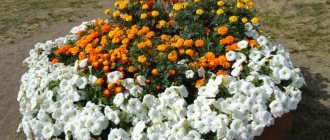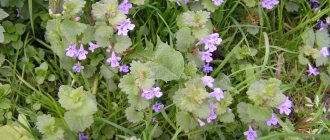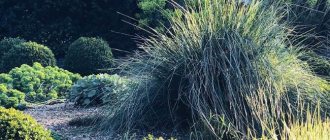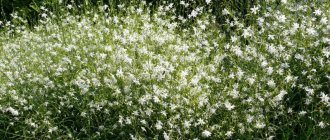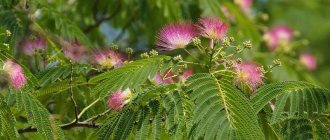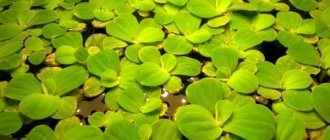Characteristics of exotic arizema
Arizema is a rather unusual, even exotic plant for European countries. This flower is a native of tropical zones; it evokes associations with something alien due to its extravagant and at the same time refined shape.
This herbaceous perennial plant has spherical tubers and several lamellar leaves divided into lobes.
This flower will decorate any flower garden
The leaves are extremely decorative and covered with silvery or reddish spots. The inflorescences resemble a spadix surrounded by a hood-like cover. Some species are distinguished by the fact that a cylindrical appendage, rolled into a tube, protrudes from the lower part of the inflorescence.
Flower growers count more than 150 species of this amazing flower in nature. But in European gardens and parks you can most often find only a few of them, which were able to successfully adapt to the climate atypical for this plant.
Description of the flower
Arizema is a flower with bright red berries. The plant prefers shaded areas with nutritious and well-drained soil. After planting, hilling is required.
To make the flower feel good, it is recommended to tie it to pegs. For the winter, the plant is covered with leaves. Reproduction - by seeds or vegetatively.
Arizema is actively used to decorate rockeries located in the shade and to create landscapes near bodies of water.
You may also be interested in the article in which we talk about popular aquatic plants for ponds.
Botanical description[edit | edit code]
The tuber is compressed-spherical, 6-7 cm in diameter.
Leavesedit | edit code
The plant has one to three leaves. The petioles are long, 5-7(30) cm long, inserted ¾ of the way into the sheaths, forming a false stem. Leaf blades are tripartite or five-fingered. The leaves are sometimes covered with whitish speckles, from oval to narrowly oblong, 7-11 cm long, 4-7 cm wide, wedge-shaped at the base, entire or serrated, sharp at the apex. The central leaflet with a petiole is 5-25 mm long, the lateral leaflets are 1-30 mm distant from the central one, the most distant ones are sessile, 9-15 cm long, oblique, wedge-shaped at the base on the inside, ear-shaped or rounded on the outside.
Inflorescences and flowersedit | edit code
The peduncle is shorter than the petioles. The spathe is greenish to dark purple, usually with pale purplish stripes. The blanket tube is cylindrical, about 5 cm long; 2 cm in diameter, obliquely truncated inside. The free part of the spathe is oval-lanceolate to oblong, 3-4 cm long, pointed at the apex.
The cob is dioecious. The female zone is semi-conical, about 2 cm long, about 1 cm in diameter at the base. Ovary oval, ovules four; the stigma is spherical. The male zone is cylindrical, about 2-3 cm long, about 2 cm wide; column weak, almost sessile; anthers, two or three; thecae are spherical, opening through the apical pores. The appendage is pedunculated, vertical, cylindrical, strong, 3-5.5 cm long, 4-5(7) mm wide, truncated base, obtuse apex.
Blooms from late April to early June.
Fruitsedit | edit code
The fruits are red, narrow-conical berries. The seeds are four in number, red, ovoid, smooth.
Chromosome number 2n
= 28, 56.
In autumn, the cob, studded with juicy scarlet berries, is visible from afar. But it’s better not to touch it: the fact is that the plant is highly poisonous and causes burns to the skin and mucous membranes; you need to be very careful with this plant.
Popular varieties
There are about 150 species in the Arizema genus. Almost all of them grow in South America and East Asia. In the subtropics and temperate zones, only 10 types of plants can be grown.
Flowering occurs in late spring or early summer. Then the arizema fades, and red shiny fruits form on the cobs. Since arizema, which is easy to grow, is poisonous, you should act with it carefully.
Three-leaved arizema
Grows in the forests of North America. The leaves are impressive in size, the length of the petioles is up to 50 centimeters. The bracts are dark purple in color and have narrow white stripes.
Dark red
American variety. An adult plant grows up to 90 centimeters in height. The blanket can be green or purple. The inflorescence is hidden under 3-part leaves.
Ciliated arizema
Homeland - China. The leaves resemble umbrellas when they open. The plant emerges from the ground only in early May. The leaves are palmate and have a thin and long tip on the spathe. If cared for correctly, the plant can reach a height of 170 centimeters.
The variety requires additional supports, otherwise the arizema will break under its own weight.
Powerful
The variety can be found on Sakhalin and the Moscow region. Propagates by self-sowing. A powerful plant with an exotic appearance.
Arizema amur
Grows in the Far East. There are about 4 separate leaves on a 35 cm root. Flowering begins in May and lasts 2 weeks. The bracts are pale green in color and have white stripes. It is located under the leaf.
Japanese Arizema
Grows in the forests of the Far East. It has 50-centimeter long petioles of brownish color. They have an original pattern that resembles snake skin.
In spring, shoot peaks with a spotted color appear from the ground. The leaves are oblong, the lobes are narrow. The plant is more thermophilic than Amur Arizema.
Japanese Arizema
This type is most often preferred by flower growers in Europe. It can be more than half a meter high and is well established in the Russian Far East, as well as in Japan, China, and Korea. The main differences are the marble patterns on the stems and the blanket covered with white stripes. Loves partial shade and grows well only on fertile soils. Vegetative propagation is not possible.
Planting and care
Planting Arizema causes some difficulties, since tubers are not easy to find. If you do get them, pay maximum attention to the flower. If Arizema takes root, it will delight you for many years with its magnificent flowering.
Tubers are planted in shady places that are well protected from the afternoon heat. The soil must be sufficiently moist, drained and nutritious. The tubers are buried to a depth of 20 centimeters. Care also includes covering the arizema for the winter with dry leaves, but it is important that they are not damaged by spores.
After heavy rains, hilling should be carried out. This is necessary so that water does not accumulate in the recesses that are located under the tubers. Tubers should be stored in winter in slightly moistened peat, the ambient temperature should be above zero.
Wintering
Among the varieties of Arizema, there are varieties that are resistant to frost, and there are also heat-loving ones. Varieties that do not tolerate low temperatures are convenient to grow in flowerpots and move indoors or to a warm greenhouse for the winter. Those that overwinter well in open ground can simply be covered with a layer of foliage.
Some, fearing frost, dig up the plant in late autumn and keep it in moistened peat in a cold room with positive temperatures.
Information! The crop is resistant to diseases and pests, but if the soil is over-moistened, the tuber, like other tubers, can rot (fusarium).
Plant propagation
Arizema is propagated vegetatively:
- seeds, with self-sowing possible;
- tubers (division or children).
It is recommended to sow seeds in August. At other times, germination is not so good. The crops will sprout in the spring. And flowering will begin only after 4 years. You can store the seeds in moistened moss, wrapped in packaging, in the refrigerator. The children are separated after autumn digging or in the spring before planting.
Snow-white arizema
This species is distinguished by special flowers: arizema throws out a peduncle up to 15 cm long, it is crowned with a majestic large inflorescence, the cover of which is decorated with wide pink, white or green stripes. Arizema snow-white has one more feature: its leaves begin to grow only after flowering has ended.
Flower growers often face this problem: due to the fact that the sprouts of this species appear quite late, the seeds do not always ripen by the end of summer.
Application in landscape design
Arizema is highly decorative. First, attention is attracted by the inflorescences, and then by the ears of the berries. Plants look great in rock gardens or near ponds. It is important that arizema is not exposed to direct sunlight.
Since Arizema is a forest plant, it should be given a place in partial shade in the garden. It is important that the soil is rich in humus and acidic. It is good if the plant is illuminated by the sun in the morning. In the autumn, the tubers should dry out, and in the summer they should not be allowed to dry out in the ground.
Frost-resistant varieties can withstand temperatures down to -30 degrees. Heat-loving arizema require shelter. Tropical plant species will need to be dug up and stored in a cool, dry place until spring. There is another simple way to preserve arisema - grow it in pots, and when it gets colder, just bring it indoors.
It is better to combine Arizema with discreet partners. Ferns or different types of Manchurian saxifrage work well.
3.Spraying
No special requirements.
↑ Up,
3.1.Irrigation of Arizema
Likes to be watered abundantly and kept dry in winter. It does not tolerate stagnant moisture at the root - the corm can rot.
3.2.Transplant
It is preferable to replant in winter - before the first shoots appear.
↑ Up,
3.3.Pests and diseases of arizema
There are no serious problems with insects, I also rarely get sick. Harmful insects may include aphids and bulb mites.
↑ Up,
3.4.Purpose
An interesting, spectacular plant.
3.5.Note
The plant contains a toxin that causes severe burning of the mucous membranes.
Hydroponics.
Features of use
You can combine rock gardens, stone slides, and sculptures with flower beds. Regularity of form is ensured by annual plants. In a composition viewed from all sides, tall plants are planted in the center.
Color also plays an important role. Warm shades help improve your mood, while cool shades calm you down. Neutral shades serve to highlight and accentuate details. However, red in excess can tire, and purple can depress and create a gloomy atmosphere. In contrast, white flowers give the composition some lightness and airiness.
Plants with bright inflorescences are ideal for emphasizing any design details. Dahlias with asters, roses with carnations, drummond phlox, bluebells, marigolds, and gladioli will add rich colors to the overall palette. For a harmonious combination, it is recommended to choose up to three different colors and use only them in the design.
First steps after purchase
You can purchase Arizema in the form of an adult plant or a tuber, which you can grow yourself. Regardless of the choice, the planting material or plant must be carefully checked. If there is the slightest suspicion of rot on the tuber, pests or traces of their activity on the leaves, it is better to refuse the purchase. It is recommended not to immediately place a new plant with the rest of the inhabitants of the home collection. Two to three weeks of observation will ensure that the acquired Arizema is completely healthy.
Briefly about the main thing
Lily is a bulbous perennial from the family of the same name, which has been successfully used in landscape design for centuries. Its popularity is due to its spectacular appearance and amazing variety of breeding varieties.
The existing classification unites hybrids into groups based on origin. Plants from each group differ in botanical characteristics, as well as in care features, which must be taken into account when choosing a variety. Lilies look spectacular in any landscape and in any type of planting. They get along well with all cultures, and companions are chosen for them based on taste and design ideas.
Growing
The container for growing Arizema must match the size of the plant, that is, ensure its stability. This is especially important when keeping large specimens. Arizema does not require frequent transplantation. Usually this procedure is carried out as the entire container is filled with roots. Evergreen species are not pruned. In specimens with a pronounced state of dormancy, the dying aerial part is removed.
Arizema responds positively to the application of mineral fertilizers. It is recommended to use them once a month during watering.
Beautiful examples
Essentially, a rose garden is a large flower garden in which only roses grow. It can be collected from different varieties or consist of only one, the most beloved. The rose garden always looks spectacular and picturesque, so it can easily become a real pearl of the garden.
A border is a low hedge. It is used to delimit sectors, for example, in a rose garden, or to highlight any specific zones. For example, a border of white roses can run along the paths, and a pink hedge can decorate the area near the gazebo and seating area. They also decorate artificial streams, planting flowers along them. The border can be easily combined with similar designs from other plants.
An arch is a gazebo made from 4 wires. Afterwards, climbing roses are attached to the wires and wrapped around them. The arch can be of any size; if desired, a bench can be installed under it, thereby creating a secluded place to relax. You should choose only climbing varieties of roses that are distinguished by lush flowering (standard, English and park). You can also form a hedge from a variety such as blue rose.
If it is not possible to place a large number of flowers, then you can plant a single rose bush. It will perfectly smooth out some of the roughness of alpine slides, walls made of stone and brick and will go well with various relief compositions.
An extraordinary solution would be to plant the bushes in special containers, which can later be placed in different places. Typically, floribunda and stamp rose are chosen. Park and English varieties are inappropriate in this case and are used very rarely.
“Stream” is an ordinary flowerbed, but designed like a stream. You can create “cascades” and “waterfalls”; they need to be taken into account when planning. Varieties are usually chosen as ground cover, and stones, pebbles or gravel are used for formation.
Massive, rough and dark stones of the alpine hill contrast perfectly with flowers that have a light and delicate color. Colorful and bright flowers look good with white stone. You can plant any variety of plants, but most often gardeners prefer miniature or ground cover species. Sometimes the slide is divided into mono-segments: one grade for each segment of the slide. It looks very unusual.
Hydrangeas fit harmoniously into a variety of floral ensembles. With their help, you can beautifully decorate your summer cottage in styles such as:
- Mediterranean. Flowers are planted in ceramic containers painted in bright colors and placed on a bed of gravel. You can also plant flowers around the perimeter of the site, and use climbing hydrangea for vertical decoration. To complete the picture, appropriate garden furniture and various decorative elements are selected;
- Oriental. This ensemble is suitable for medium or small leveled areas. The main accent is the flower beds, in which the flowers create a unique pattern, and a large number of paths;
- Rustic. The style is also distinguished by the presence of many flowering plants (flower beds and beds). To create the appropriate rustic atmosphere, plants are planted in buckets, watering cans and even cans. Also, the so-called flower cart, which can be placed in the garden, will fit perfectly here;
- English. The style is suitable only for a well-lit area with fertile soil. The English ensemble includes elements such as hedges, lawns, paths and garden houses. In the central area of the composition, you can use, for example, a combination of hydrangea with cold-resistant geranium and ornamental grass. The result will be an elegant, but at the same time strict composition in full accordance with the style.
How to make a flowerbed with your own hands, see the following video.
